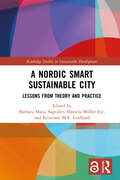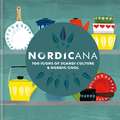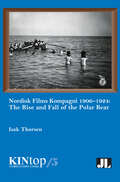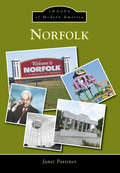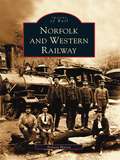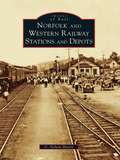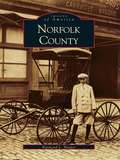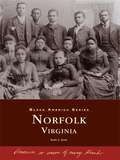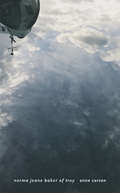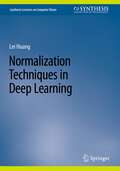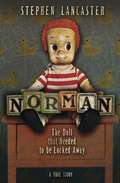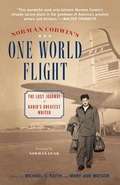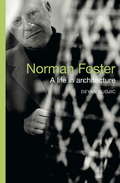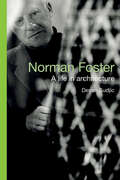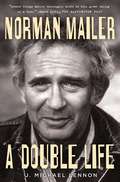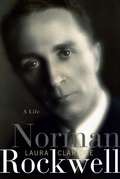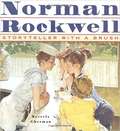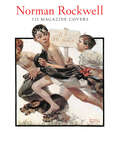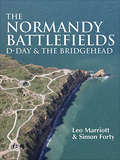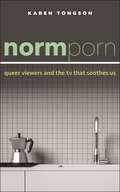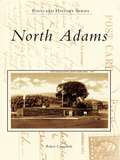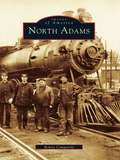- Table View
- List View
A Nordic Smart Sustainable City: Lessons from Theory and Practice (Routledge Studies in Sustainable Development)
by Barbara Maria SageidetThis book critically explores research and development on the smart sustainable city, emphasizing the tension and association between smartness and sustainability, both as a concept and as a phenomenon in a Nordic context.Worldwide, increasing urbanization and its related challenges, along with urgent environmental issues, have sped up the international interest for smart, sustainable cities as a concept that could increase the efficiency of services, minimize environmental impacts, and improve the quality of living in cities and urban areas. This book scientifically discusses the provenance, substance, and processes of the smart sustainable city, with illustrative examples of how it is translated into urban realities in a medium-sized city, drawing upon Stavanger, one of the first, and one of the leading smart sustainable cities in Europe. The book’s multidisciplinary perspectives and thematic lenses include education and knowledge, arts and culture, safety, climate and sustainability, mobility and transport, economics, democracy, participation, innovation and entrepreneurship, data, and communication. While demonstrating the academic breadth and wide-ranging impact of the smart sustainable city concept, the book promotes and updates the ground for mutual understanding, communication, and collaboration between multiple disciplines and stakeholders involved in developing functional, democratic, and sustainable solutions for the urban present and future.A Nordic Smart Sustainable City: Lessons from Theory and Practice presents an overview of scientific and practical current approaches in a readable format for practitioners and administrators in municipalities and related businesses, for researchers, academics, educators, students, and stakeholders.
Nordicana: 100 Icons of Scandi Culture & Nordic Cool
by Kajsa Kinsella Arrow Film Distributors LtdYou've watched every Scandi TV series going, you have Nordic light fittings, and you want Birgitte Nyborg as your Prime Minister. Yes it's fair to say there is a general love-in with everything related to the northern countries.Over the last decade, the Nordic nations have quietly and unassumingly come to hold us in their thrall; but what is it, exactly, that we covet about their culture?Nordicana celebrates the objects, aesthetics and traditions that have inspired our obsession, with a quick introduction to 100 icons of Scandi style and Nordic cool, accompanied by beautiful illustrations.
Nordisk Films Kompagni 1906-1924, Volume 5: The Rise and Fall of the Polar Bear
by Isak ThorsenNordisk Films Kompagni 1906–1924: The Rise and Fall of the Polar Bear is the first comprehensive study of the Danish film company, Nordisk Films Kompagni, in the silent era. Based on archival research, primarily in the company’s surviving business archives, this volume of KINtop describes and analyzes how Nordisk Film became one of the leading players in the world market and why the company failed to maintain this position. This volume is written from perspective of Nordisk Film as a business and organization, from its establishment in 1906 until 1924 when founder Ole Olsen stepped back. Among the many topics and themes this volume examines are the competitive advantages Nordisk Film gained in reorganizing the production to multiple-reel films around 1910; the company’s highly efficient film production which anticipated the departmentalized organization of Hollywood; Nordisk Film’s aggressive expansion strategy in Germany, Central-Europe and Russia during the First World War; and the grand plans for taking control of UFA in association with the American Famous Players in the post-war years.
Norfolk (Images of Modern America)
by Janet PortinerIn July 1866, three wagon trains of German immigrants from Wisconsin arrived at their new home on the North Fork of the Elkhorn River in northeastern Nebraska. The settlers intended to call the town Northfork, but in 1868, when the abbreviated "Norfork" was submitted to federal postal authorities, the government assumed the name was misspelled and changed it to Norfolk. Since the town's founding, the story of the community has been one of continuous growth that has led to a bountiful, thriving town. Norfolk's hardworking people are generous, welcoming, and open to new ideas. Though it has changed with time, the unconquerable spirit of the city remains young and active. Images of Modern America: Norfolk is a photographic journey into the 21st century.
Norfolk and Western Railway (Images of Rail)
by Nelson HarrisFor a century, the Norfolk and Western Railway operated as one of the greatest transportation companies in the southeastern United States. From developing the coal fields of West Virginia to accommodating passengers aboard its famous Powhaten Arrow and Pocahontas lines, the N&W was the last major railroad to abandon the steam engine. The story of the N&W is a story about people-a story of the tens of thousands of people who worked in the shops and aboard the trains, sold the tickets and moved the freight, laid the track and managed corporate affairs. Images of Rail: Norfolk and Western Railway celebrates that heritage through the lens of some 200 archival photographs.From images of the muscular Class J steam locomotive to the lone agent of the rural depot, these photographs have been harvested from the N&W's files at the Virginia Museum of Transportation. The archival material provides the reader the rare opportunity to rummage through the N&W's attic. See the engine crews at the turn of the last century, the shop gangs, freight agents, roundhouses, stations, and iron horses of a bygone age. With views of the rugged and, at times, dangerous days of railroading in the late 1800s to the rise of the N&W as a member of America's corporate elite, these pictures convey the railway's storied history.
Norfolk and Western Railway Stations and Depots
by C. Nelson HarrisThe tracks of the Norfolk and Western Railway snaked through Virginia's Shenandoah Valley and the coalfields of West Virginia. For nearly 100 years, the Norfolk and Western brought freight, passengers, and economic vitality to large cities and rural mining towns. At each stop was the depot or station; some stations were large, architecturally ornate structures that represented the muscular energy and romantic era of this great steam railway with its famed J-class engines. In other places there were small wooden depots that depicted the hard-scrabble life of the mining communities, tucked amid steep mountain valleys that were indelibly shaped by the railway's presence. Today some of those structures remain, while many disappeared when the railway ceased passenger or other service. The Norfolk and Western eventually merged with the Southern Railway, and though the trains of the Norfolk Southern still run along those same lines, they simply pass by where they used to stop many years ago.
Norfolk County (Images of America)
by Raymond L. HarperA major player in the country's development, Norfolk County possesses a unique history, one that reflects the many challenges and accomplishments that America has experienced since the country's birth in the late eighteenth century. The county's citizens have weathered a variety of storms, both natural and manmade, ranging from hurricanes, floods, British occupation and attacks, Federal occupation, and aggressive civic annexation, and have created a beautiful and useful landscape, appealing to both the artist's eye and industrialist's practicality.This volume, with over 200 black-and-white images, takes readers into one of the Tidewater region's most historic locations and into an age made memorable by its unpaved roads, its early streetcars and horse-drawn wagons, its lively waterfront district on the Elizabeth River, and its emerging cityscape bordered by picturesque dairy farms. A rare visual journey, Norfolk County explores, through word and image, the area's diverse past, touching upon many elements of everyday life, including scenes of early one-room schoolhouses, historic churches, well-known industries, lush countrysides, and life along the river, as well as capturing vintage views of Great Bridge, Deep Creek,and the Great Dismal Swamp.
Norfolk, Virginia (Black America Series)
by Ruth A. RoseNorfolk has been a center of African-American life since this country's humble beginnings, when indentured African servants arrived in 1619 to the Tidewater region. Since that time, the African-American population has endured the atrocities of slavery, poverty, and inequality, and has emerged, through a remarkable combination of hard work, perseverance, and faith, as a vibrant community and an integral component to the identity and success of Norfolk and surrounding areas.
Norma Jeane Baker of Troy (Oberon Modern Plays Ser.)
by Anne CarsonAnne Carson’s new work that reconsiders the stories of two iconic women—Marilyn Monroe and Helen of Troy—from their point of view Norma Jeane Baker of Troy is a meditation on the destabilizing and destructive power of beauty, drawing together Helen of Troy and Marilyn Monroe, twin avatars of female fascination separated by millennia but united in mythopoeic force. Norma Jeane Baker was staged in the spring of 2019 at The Shed’s Griffin Theater in New York, starring actor Ben Whishaw and soprano Renée Fleming and directed by Katie Mitchell.
Normal People: The Scripts
by Sally RooneyDelve deeper into the Emmy- and Golden Globe–nominated Hulu series based on Sally Rooney's bestselling novel with this must-have collection of the Normal People scripts, featuring behind-the-scenes photos and an introduction by director Lenny Abrahamson.&“You know, I did used to think that I could read your mind at times.&”&“In bed you mean.&”&“Yeah. And afterwards but I dunno maybe that's normal.&”&“It&’s not.&”Connell and Marianne grow up in the same small town in the west of Ireland, but the similarities end there. In school, Connell is popular. Marianne is a loner. But when the two strike up a conversation, something life-changing begins.With an introduction by director Lenny Abrahamson and featuring iconic images from the show, Normal People: The Scripts contains the complete screenplays of the acclaimed Emmy- and Golden Globe–nominated television drama that The New York Times called &“an unusually thoughtful and moving depiction of young people&’s emotional lives.&”
Normalization Techniques in Deep Learning (Synthesis Lectures on Computer Vision)
by Lei HuangThis book presents and surveys normalization techniques with a deep analysis in training deep neural networks. In addition, the author provides technical details in designing new normalization methods and network architectures tailored to specific tasks. Normalization methods can improve the training stability, optimization efficiency, and generalization ability of deep neural networks (DNNs) and have become basic components in most state-of-the-art DNN architectures. The author provides guidelines for elaborating, understanding, and applying normalization methods. This book is ideal for readers working on the development of novel deep learning algorithms and/or their applications to solve practical problems in computer vision and machine learning tasks. The book also serves as a resource researchers, engineers, and students who are new to the field and need to understand and train DNNs.
Norman: The Doll That Needed to Be Locked Away (A True Story)
by Stephen LancasterNorman takes you on a chilling journey into Stephen's life with a doll that has held the spirit of an unborn child for over fifty years--a haunted doll that still lives in Stephen's house.
Norman Corwin's One World Flight: The Lost Journal of Radio's Greatest Writer
by Norman Corwin Michael C. Keith Mary Ann WatsonA towering figure in broadcast history, Norman Corwin has long been known as "Radio's Poet Laureate." In the late 1930s, a creative revolution was underway in the medium. What some people still called "the wireless" was maturing from a novelty into an art form. After a ten-year career as a newspaperman, columnist, and critic--which began at the age of 17--Corwin joined the ranks of aural provocateurs such as Archibald MacLeish, Arch Oboler, and Orson Welles.
Norman Foster: A Life in Architecture
by Deyan SudjicA biography of Lord Foster, one of the world's foremost architects, written with his full co-operation.Norman Foster is a phenomenon - as an architect, but also as an individual. He is responsible for a dozen or more of the most recognisable buildings of the last thirty years. Under his driven leadership, what is now called Foster and Partners has grown to an international firm with almost 1,000 employees, building astonishing constructions all over the world. Deyan Sudjic explores the nature of the impact that he has had on architecture, and on the contemporary city. It traces his remarkable journey from the backstreets of Manchester, the determination with which he has built a global architectural practice, and his huge creative impact on what we see around us.Amongst many other buildings, Norman Foster is responsible for the design of Beijing's new airport, one of the world's largest, for the Rossiya tower in Moscow, in contention to be the tallest skyscraper in Europe until the credit crunch killed it, for one of the towers at Ground Zero in Manhattan, and for a crop of new towers in London. He designed the Reichstag, the Hong Kong and Shanghai Banks headquarters in London and China, the new Wembley stadium and the British Museum's new court.Deyan Sudjic's insightful and elegantly written biography charts the remarkable life of one of the world's most influential architectural figures.
Norman Foster: A Life in Architecture
by Deyan SudjicA biography of Lord Foster, one of the world's foremost architects, written with his full co-operation.Norman Foster is a phenomenon - as an architect, but also as an individual. He is responsible for a dozen or more of the most recognisable buildings of the last thirty years. Under his driven leadership, what is now called Foster and Partners has grown to an international firm with almost 1,000 employees, building astonishing constructions all over the world. Deyan Sudjic explores the nature of the impact that he has had on architecture, and on the contemporary city. It traces his remarkable journey from the backstreets of Manchester, the determination with which he has built a global architectural practice, and his huge creative impact on what we see around us.Amongst many other buildings, Norman Foster is responsible for the design of Beijing's new airport, one of the world's largest, for the Rossiya tower in Moscow, in contention to be the tallest skyscraper in Europe until the credit crunch killed it, for one of the towers at Ground Zero in Manhattan, and for a crop of new towers in London. He designed the Reichstag, the Hong Kong and Shanghai Banks headquarters in London and China, the new Wembley stadium and the British Museum's new court.Deyan Sudjic's insightful and elegantly written biography charts the remarkable life of one of the world's most influential architectural figures.
Norman Foster: A Life in Architecture
by Deyan SudjicThe author of The Language of Things “takes readers on an engrossing tour of Foster’s life” from childhood to the world-renowned buildings he designed (Publishers Weekly, starred review).A leading pioneer of high-tech architecture, Norman Foster has worked across the globe, collaborating with luminaries such as R. Buckminster Fuller to Steve Jobs. Born in Manchester, England, Foster grew up in poverty, the son of a machine painter. He served in the Royal Air Force and worked in a local architect’s office before returning to school for architecture. Foster went on to design the Reichstag, the Hong Kong and Shanghai Banks headquarters in London and China, the new Wembley stadium and the British Museum's new court. He is also responsible for the design of Beijing's new airport, the Rossiya tower in Moscow, one of the towers at Ground Zero in Manhattan, as well as numerous other buildings around the world. In this insightful biography, Deyan Sudjic charts Foster’s remarkable life and career.
Norman Mailer: A Double Life
by J. Michael LennonFrom the biographer who knew Norman Mailer for decades comes the definitive, authorized portrait of the eminent novelist, journalist, and controversial public figure, based on extensive interviews and unpublished letters.Norman Mailer was the one of the most famous writers of his generation, a figure as notorious for his stormy romances and quarrels with other writers as he was respected for his numerous bestsellers and literary accolades. In this candid biography, J. Michael Lennon brings a wealth of research informed by his years of personal acquaintance with Mailer, as well as the cooperation of Mailer's family, to reveal the life and work of an American legend. In a career that produced eleven bestsellers, Mailer lived through every great postwar event of the twentieth century and commented on many of them. From his initial success with his World War II novel The Naked and the Dead, through his observations on the convulsive 1960s in the Pulitzer Prize-winning Armies of the Night, to his own quixotic run for mayor of New York City, his life was a reflection of the turbulent times in which he lived. A man of sharp complexities, he was loved and loathed, the most prominent public intellectual of his time, at once an outspoken critic of the Vietnam War and the bête noir of the women's rights movement. Lennon explores Mailer's dualities: journalist and activist, devoted family man (he was married six times and was the father of nine children) and notorious philanderer, intellectual and fighter, writer and public figure, all of them evolving through Mailer's self-conscious effort to create a distinctive identity for himself. Capturing this protean life as never before, Norman Mailer: A Double Life gives us the man in full--a remarkable and unique figure, a giant in the context of his time.
Norman Rockwell
by Laura ClaridgeNorman Rockwell’s tremendously successful, prolific career as a painter and illustrator has rendered him a twentieth-century American icon. However, the very popularity and accessibility of his idealized, nostalgic depictions of middleclass life have caused him to be considered not a serious artist but a “mere illustrator”–a disparagement only reinforced by the hundreds of memorable covers he drew for The Sunday Evening Post. Symptomatic of critics’ neglect is the fact that Rockwell has never before been the subject of a serious critical biography. Based on private family archives and interviews and publishes to coincide with a major two-year travelling retrospective of his work, this book reveals for the first time the driven workaholic who had three complicated marriages and was a distant father —so different from the loving, all-American-dad image widely held to this day. Critically acclaimed author Laura Claridge also breaks new ground with her reappraisal of Rockwell’s art, arguing that despite his popular sentimental style, his artistry was masterful, complex, and far more manipulative than people realize.
Norman Rockwell: Storyteller with a Brush
by Beverly Gherman Family Trust RockwellHe was a pale, skinny boy with thick glasses, but Norman Perceval Rockwell knew that he could draw. Beverly Gherman shows us how this awkward boy grew up to become a famous illustrator. As a boy, he sketched the characters from Charles Dickens's novels at the kitchen table. And although his mother discouraged him from pursuing a career in art, Norman knew early on that he could not ignore his talent. He dropped out of school at age fourteen to study art and begin the career that would eventually capture the heart of his entire nation. The experiences of Rockwell's life became part of his paintings: a childhood trip to the country, his son's departure for the Air Force, the fire that destroyed his studio. He also depicted world events and people of his time: Charles Lindbergh's flight across the Atlantic Ocean, the soldiers of World War II, and the children involved in school integration, as well as more intimate American scenes, such as a family dinner or a trip to the doctor's office. Beverly Gherman paints a colorful and engaging portrait of Norman Rockwell's life, enhanced by full-color reproductions of the artist's own paintings, which tell both his story and their own.
Norman Rockwell 332 Magazine Covers: 332 Magazine Covers (Tiny Folio Ser.)
by Christopher FinchNow available for the first time as an e-book, Norman Rockwell 332 Magazine Covers features Rockwell's unique vision of America. All of his his justly famous cover illustrations for the Saturday Evening Post, painted between 1916 and 1963, are reproduced in splendid full color in a digital format, with commentaries by Christopher Finch, the noted writer on art and popular culture.There are few more satisfying sights on a city street than a well-stocked newsstand, hung with a hundred or more magazines and periodicals, each competing for the attention of the potential customer. The American magazine cover enjoyed a Golden Age during the period that opened with the high-speed color press, and ended when subscription sales grew to paramount importance. Dozens of gifted artists made their reputations in this field. None of them, however, achieved the immense and sustained popular success enjoyed by Norman Rockwell.Although technically he was an academic painter, he had the eye of a photographer and, as he became a mature artist, he used this eye to give us a picture of America that was familiar-astonishingly so-and at the same time unique. The picture seemed familiar because it was everyone's dream of America; it was unique because only Rockwell managed to bring it to life with such authority. Rockwell held up a friendly mirror to the society he lived in, and Americans have looked into this glass and seen themselves as warm, decent, hard-working citizens of a country bountiful enough to accommodate their boundless optimism.
The Normandy Battlefields: D-Day and the Bridgehead (Then And Now Ser.)
by Simon Forty Leo MarriottExperience the battlefields of D-Day in this beautiful book combining historical images, full-color aerial photography, and informative text. The D-Day invasion of Nazi-occupied Normandy was the most dramatic turning point of World War II. With a combination of historic and contemporary photography, along with maps and other illustrations, The Normandy Battlefields takes readers &“on-site&” to the sacred battlegrounds. The armada that attacked from Britain left behind many signs of their passage. The Normandy Battlefields details what can be seen on the ground today using a mixture of media to provide a complete overview of the campaign. Maps old and new highlight what has survived and what hasn&’t; then-and-now photography allows fascinating comparisons with the images taken at the time, and computer artwork provides graphic details of things that can&’t be seen today. The book describes the area from Cherbourg to Le Havre by way of the key D-Day locations, providing a handbook for the visitor and an overview for the armchair traveler. It covers the forces from both sides and the memorials to those young men who fought so many years ago.
The Normans in Sicily: Being A Sequel To “An Architectural Tour in Normandy”
by Henry Gally KnightAn historical account of the Normans, paired with a travelogue based on an architectural tour of Sicily to study the influence of the Normans, by a British M.P., traveler, and writer who served as High Sheriff of Nottinghamshire in 1814-15.Knight was the only son of Henry Gally (afterwards Gally Knight), barrister, of Langold, and was educated at Eton and Trinity Hall, Cambridge. He succeeded in 1808 to estates at Firbeck and Langold Park which his father had inherited in 1804 from his brother John Gally Knight.Knight was appointed High Sheriff of Nottinghamshire for 1814–1815. He also held the office of deputy-lieutenant of Nottinghamshire. He was a Member of Parliament for the constituencies Aldborough (12 Augst 1814-April 1815), Malton (1831–1832; 31 March 1835-9 February 1846), North Nottinghamshire (1835 and in 1837). In parliament he was a fluent but infrequent speaker. He was also a member of the commission for the advancement of the fine arts.Knight owned Firbeck Hall in Rotherham. Sir Walter Scott's novel Ivanhoe is set nearby, and Knight may have been Scott's source of local information when he was writing the book. He was admitted a Fellow of the Royal Society on 20 May 1841.
Normporn: Queer Viewers and the TV That Soothes Us (Postmillennial Pop #38)
by Karen TongsonAn irreverent look at the love-hate relationship between queer viewers and mainstream family TV shows like Gilmore Girls and This Is Us After personal loss, political upheaval, and the devastation of the COVID-19 pandemic, many of us craved a return to business as usual, the mundane, the middlebrow. We turned to TV to find these things. For nearly forty years, network television has produced a constant stream of “cry-along” sentimental-realist dramedies designed to appeal to liberal, heterosexual, white America. But what makes us keep watching, even though these TV series inevitably fail to reflect who we are?Revisiting soothing network dramedies like Parenthood,Gilmore Girls, This Is Us, and their late-80s precursor, thirtysomething, Normporn mines the nuanced pleasures and attraction-repulsion queer viewers experience watching liberal family-centric shows. Karen Tongson reflects on how queer cultural observers work through repeated declarations of a “new normal” and flash lifestyle trends like “normcore,” even as the absurdity, aberrance, and violence of our culture intensifies. Normporn allows us to process how the intimate traumas of everyday life depicted on certain TV shows—of love, life, death, and loss—are linked to the collective and historical traumas of their contemporary moments, from financial recessions and political crises to the pandemic.Normporn asks, what are queers to do—what is anyone to do, really—when we are forced to confront the fact of our own normalcy, and our own privilege, inherited or attained? The fantasies, the utopian impulses, and (paradoxically) the unreality of sentimental realist TV drama creates a productive tension that queer spectators in particular take pleasure in, even as—or precisely because—it lulls us into a sense of boredom and stability that we never thought we could want or have. .
North Adams
by Robert CampanileThe history of North Adams is a portrait of survival and a celebration of diversity, which is not only expressed in its citizens and their ancestry but also in the many faces that the city and its environment have taken on through the years. From the isolated military outpost that fought a dramatic battle in the mid-1700s, through the roller-coaster ride of prosperity and economic depression endured by its citizens, North Adams exemplifies the strength that is a trademark of New England. North Adams contains an unusual collection of rare photographs that celebrate every aspect of the city. The book exemplifies how the population is a mosaic of cultures that sought a better life and wove an atmosphere of acceptance and sharing. An important part of that better life included the industry that made indelible imprints on the nation's history by producing pig iron for the Civil War's famous Monitor ironclad, by the engineering feat of the Hoosac Tunnel, and by leading the nation in the manufacture of fabrics, shoes, and electric capacitors. The diverse architecture that dominates hillside church steeples, the long gone Victorian depot station, the devastating floods, the majestic hot-air balloons, and the everyday faces of citizens are all captured here in striking photographs. Together they create the story of a city that always found a way to survive.
North Adams (Images of America)
by Robert CampanileThe history of North Adams is a portrait of survival and a celebration of diversity.This celebration is not only expressed in its citizens and their ancestry but also in the many faces that the city and its environment have taken on through the years. From the isolated military outpost that fought a dramatic battle in the mid-1700s, through the roller-coaster ride of prosperity and economic depression endured by its citizens, North Adams exemplifies the strength that is a trademark of New England. North Adams contains an unusual collection of rare photographs that celebrate every aspect of the city. The book exemplifies how the population is a mosaic of cultures that sought a better life and wove an atmosphere of acceptance and sharing. An important part of that better life included the industry that made indelible imprints on the nation's history by producing pig iron for the Civil War's famous Monitor ironclad, by the engineering feat of the Hoosac Tunnel, and by leading the nation in the manufacture of fabrics, shoes, and electric capacitors. The diverse architecture that dominates hillside church steeples, the long gone Victorian depot station, the devastating floods, the majestic hot-air balloons, and the everyday faces of citizens are all captured here in striking photographs. Together they create the story of a city that always found a way to survive.
